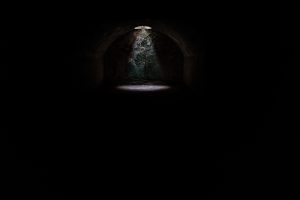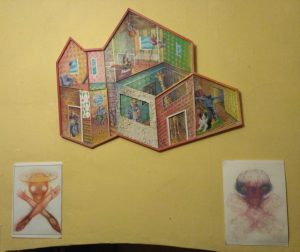The best known book in the genre is probably Neuromancer by William Gibson, and barring a few glaring anachronisms (in either this book or its sequel Count Zero, someone tries to sell “three megs of hot RAM”) it still stands up as a damn good book. The roots go back much further, though, to the sci fi of the 60s and 70s, perhaps even as far back as The Stars My Destination by Alfred Bester, from 1957 (also an excellent book, if a little dated, incidentally).
Cyberpunk is a genre characterized by a dystopian society, huge wealth inequality, and large amounts of technology – usually body modification and computer technology. Protagonists tend to be outsiders, fighting the megacorporations, all-powerful AIs and corrupt law enforcement for the little guy. Often these heroes are using scrounged together tech and stolen weapons to fight overwhelming odds and somehow coming out the other side through a combination of skill, luck and panache. There is also usually a lot of neon and chrome.
This makes it a great genre for roleplaying in. Much of the genre plays it straight, varying names of megacorporations and specifics of technology available in much the same way as classic fantasy will vary the names of kings and magics available. But one of the most popular blends this with classic fantasy to create a setting where megacorporations employ elven mages to fight anarchist shamans while expert hackers go toe to toe in the matrix and orc street samurai wade into battle with a katana in one hand a and a shotgun in the other (okay, that was kinda my last character) – that game is Shadowrun. I love the setting but the system… well the system not so much. Recently, though, I played a Shadowrun Anarchy campaign which worked far better than the standard version, and the computer games, Shadowrun Returns, Shadowrun Dragonfall and Shadowrun Hong Kong capture the feel of the world rather well (well I’ve not played the third one yet, but I have a copy).
Variants
Much as the cyberpunk ethos encourages tearing technology apart to build something new, so the genre has been torn apart and rebuilt to create many variants, all helpfully identified by the suffix “-punk”. Generally they maintain a dystopian future and a punk attitude, but the nature of the technology and the emergent threats change.
Magic-punk is where technology is replaced with magic – gigantic magical machines power everything, often magic can be almost coded like a computer, and personal augmentation may be replaced by daemonic – and often demonic – summoning and possession. This hews closer to classic fantasy than Shadowrun, which is definitely a cyberpunk system despite the heavy influence of magic.
Dieselpunk is not, as you may guess, a setting in which everything is powered by Vin Diesel, but rather one where the technology being hacked is more likely to be cars and trucks and the most valuable resources are likely to be fuel and water. The most famous example is probably Mad Max.
Steampunk started out as a kind of retro-Victorian variant of the genre in which all the amazing technology was powered by that latest of inventions the steam engine. It has since taken on a life of its own however and become genre and style involving an awful lot of brass cogs!
Transhumanism
Transhumanism is kind of a special case of a variant. While cyberpunk focuses more on the technology, transhumanism is more philosophical and asks the questions “What is human?” and “how far can we alter a person before they stop being a person and become something else?” These questions are not unique to transhumanism, of course, but it places them front and centre.
Transhumanists take ideas to their logical conclusion – If you replace a leg or an arm then a person is still a person, but what happens if you replace more? The heart, the sensory organs, the brain? If the brain can be mapped, then can it be modelled in a powerful enough computer? If so is that computer a person? If you copy someone’s brain is the copy the same person? How about if you then download that brain into a new body? What if it’s an entirely robotic body?
These and more questions are clearly very very hard to answer and don’t obviously lend themselves to a roleplaying game so much as a discussion down the pub! So the most popular game in the genre, Eclipse Phase, hews back towards cyberpunk with powerful corporations and evil AIs to fight, and revolutionary politics to foster that conflict, but those corporations are not megacorps, they’re smaller and more agile than that, and the AIs are hyper-intelligent beyond human comprehension, and have fled for reasons unknown.
The Future
So is cyberpunk the future? I hope not – the technology is pretty cool, and the style is certainly striking, but the dystopian inequality and constant threat of violence for those on the fringes is less promising. Personally I’d like to skip past all that and just upload my mind to the internet!
Please follow and like us:






